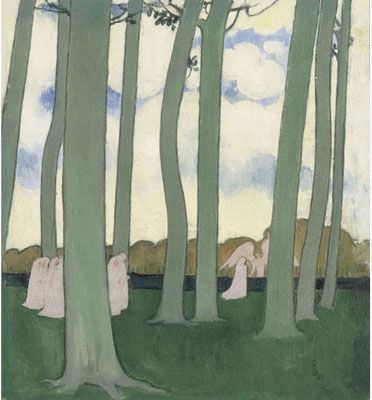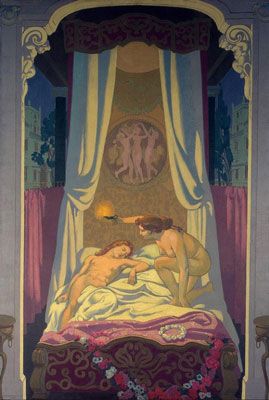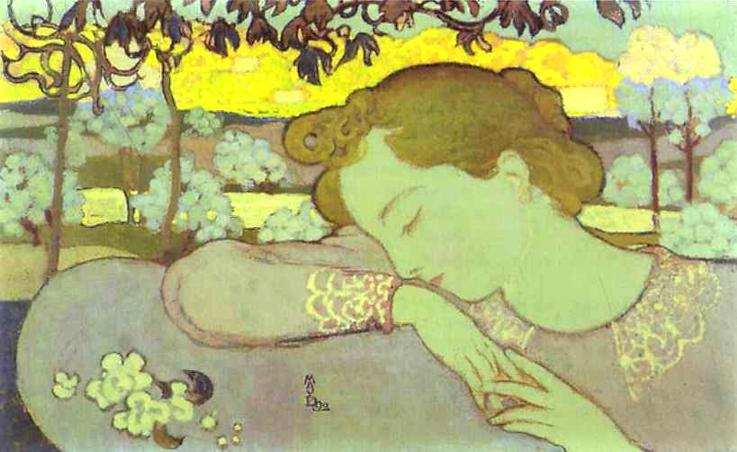Maurice Denis

Maurice Denis was a French Painter born on November 25th in 1870.During his lifetime he wore a series of different hats, being involved in the Les Nabis (a group he co-founded), the Symbolist movement, and later a relapse into the neoclassical. Denis is an odd artist to place, as he specifically represents the bridge between post impressionistic art and modern art. Denis’s work is caught in a gray area between the two. His work, utilizes techniques such as brushwork from the impressionists, but his theories contributed to the cubist, fauvist and abstract movements in art. Additionally, Denis was also a celebrated art critic who published many essays on aesthetics and spirituality.
Les Nabis & Religion
Denis with Paul Sérusier,co-founded the art group “Les Nabis” (derived from the Hebrew and Arabic word for “prophet”) in 1888 which was is officially categorized as an post-impressionist avant garde movement. The group was associated with mysticism and symbolism, and their goal was to reinvigorate art,seeing themselves “prophets” from a higher power. Thus, the name “Les Nabis” was coined by Auguste Cazalis, who saw the group’s attempts to reflect those of ancient prophets.

Stylistically, the group took took impressionist brushwork and overlay it with bright colours (they were particularly interested in using colour symbolically and distorting line). Yet, within the group there was much room for stylistic interpretation of the movement. However, their motto that “sounds, colors, and words have a miraculously expressive power beyond all representation and even beyond the literal meaning of the words” remained as the overarching theme in all the works the group produced.
Denis produced many works during this time, and his own faith played an integral role in much of his work. One of his earlier works, “Le Mystere Catholic” painted in 1889 is an especially good example of this. The painting depicts the a catholic ceremony celebrating Gabriel’s appearance to mary. A scene which Denis depicted on six different occasions (with this one being his second one), and was one of his many religious works. However, this scene differs from many traditional interpretations, as it seemingly reimagined in an almost modern context. Additionally, Denis injects the painting with a layer of meaning by using the figures as symbolic representations for biblical figures, straying from their classical depictions. The altar boys and priests can be seen as the angels, and the lady in white is Mary, whose hands lay fingering over her stomach (foreshadowing her impregnation). Denis utilities soft, dreamlike colours reminiscent of Renaissance artists, which invoke a sense of other worldliness and spirituality (a very Nabi like approach). The colours in this particular piece are a specific callback to Fra Angelico’s works.
A Lapse into The Neo-Classical

Later on in his career, we see a shift from religious work and towards the neoclassical. This period of his art was less prominent than the others, however he still produced many beautiful pieces depicting classical scenes. For example, his 1908 “The Story of Psyche” is perhaps his most well known of his neoclassical works, a panel of three which depicts the Greek myth of Psche and Eros. In this period, there is a clear jump in his style. Denis has abandoned the Nabi approach to art, disregarding the organic shapes and abstraction in favour of realism and perspective. The figures in this piece are much more realistic and defined than his earlier ones, however they still remain as stylized and idealized interpretations of the human form. Additionally, they show clear influence from Renaissance artists such as Michelangelo and Raphael.
Opinion
Denis’s works all greatly differ in style and content which make it somewhat more difficult to pinpoint an overarching opinion of all of his work. I like his sense of colour, especially in some of his earlier works (I really like the colours in “Le Mystere Catholique”), I find that his use of colour creates a very unique mood which I don’t see in other artist’s work. Additionally, I like the way he depicts figures, especially in their more stylized forms , for example Le mystere Catholic and The story of Psyche bear little resemblance to each other but I enjoy both interpretations of people.But I don’t care for some of his most well known works such as the “Landscape with Green Trees” as I think his use of colour is a little disappointing and I don’t find the composition or the subject compelling. Similarity I don’t find I particularly understand or relate to the theory and philosophy of the Nabis.

Sources
* https://www.theartstory.org/movement-les-nabis.htm
*https://www.theartstory.org/artist-denis-maurice-artworks.htm
*https://www.theartstory.org/artist-denis-maurice.htm
*http://www.visual-arts-cork.com/history-of-art/nabis.htm
Picture Sources (in order)
*https://www.wikiart.org/en/maurice-denis
*https://www.theartstory.org/artist-denis-maurice-artworks.htm
*http://www.musee-mauricedenis.fr/maurice-denis/quelques-oeuvres/article/triple-portrait-de-marthe-fiancee
**https://www.theartstory.org/artist-denis-maurice-artworks.htm
*https://www.wikiart.org/en/maurice-denis/sleeping-woman-1892